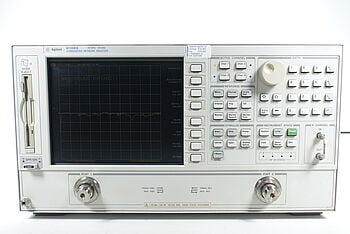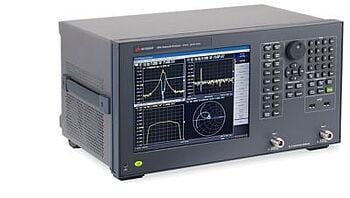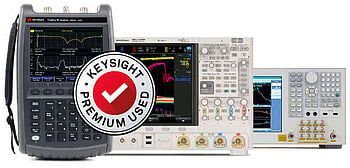- Introduction
- Bandwidth Fundamentals
- Types of Bandwidth and Their Applications
- Analog and Digital Bandwidth
- Baseband and Passband Bandwidth
- Information and Signal Bandwidth
- Specific Use Cases in Electrical Engineering
- Key Bandwidth Formulas: Nyquist and Shannon-Hartley
- Nyquist Theorem
- Shannon-Hartley Theorem
- Bode Plots for Electrical Engineers
- Key Features of Bode Plots
- Bandwidth in Transmission Lines and Filters
- Transmission Line Theory, Signal Integrity, and Technical Considerations
- Effects of Bandwidth on Filter Design and Performance
- Techniques for Optimizing Bandwidth
- Impact of Bandwidth on Overall System Performance
- Measuring Bandwidth with Keysight Technologies
- Time-Domain Reflectometry (TDR)
- Vector Network Analyzer
- Oscilloscope-Based Methods
- Comparison of Filter Types and Their Bandwidth Characteristics
- Bandwidth Optimization Strategies for Electrical Engineers
- Equalization Techniques
- Impedance Matching
- Shielding and Grounding Best Practices
- Common Bandwidth Optimization Techniques
- Emerging Trends and the Future of Bandwidth
- The Advent of 5G and Future Communication Technologies
- Role of Artificial Intelligence and Machine Learning
- Electrical Engineers Shaping Bandwidth Innovations
- Key Trends in Bandwidth Management and the Impact on Electrical Engineers
- Final Thoughts from Keysight
- Whenever You’re Ready, Here Are 4 Ways We Can Help You
Electrical engineering is a field marked by precision, optimization, and an intimate understanding of key mathematical principles. Among these, the bandwidth formula looms large—a critical compass guiding engineers through the complex maze of signal processing systems.
Whether it's crafting the blueprint for a next-generation wireless communication protocol or fine tuning a high-speed data center, the measurement of bandwidth can often tip the scales between success and failure. Simply put, the bandwidth formula defines the range of frequencies a system can accommodate: Bandwidth = f_max – f_min.
In this guide, we delve into the intricacies of the bandwidth formula, its impact on the day-to-day tasks of electrical engineers, and how leveraging resources like the Keysight Used Equipment Store can help. This platform, tailor-made for engineers, serves as an invaluable tool for navigating the complex field of electrical engineering with a vast selection of tools designed to address their unique requirements.
With an extensive array of previously owned devices and instruments, the store enables professionals to fully capitalize on cutting-edge resources ensuring that they can select the most appropriate and efficient equipment for their specific needs.
"Understanding bandwidth is akin to mastering the language of electrical engineering—it’s our main line of communication from source to receiver." – Robert W. Lucky, Bell Labs]
Bandwidth Fundamentals
Bandwidth, a critical term in the realm of electrical engineering, represents the difference in frequency between the upper (f_max) and lower (f_min) limits of a continuous frequency band. It quantifies the range of frequencies a system can handle, directly influencing data transmission rates, signal integrity, and system capacity. Understanding and manipulating bandwidth is crucial to designing effective electrical and communication systems.
Several factors impact bandwidth, including the quality of transmission media, signal-to-noise ratio, and the technology used. For instance, higher-quality cables or fibers may allow for greater bandwidth, while improving the signal-to-noise ratio could boost data transmission rates. Similarly, advancements in technology can enable more efficient encoding techniques, thereby increasing bandwidth.
In the real world, the significance of bandwidth becomes evident in numerous applications. It's crucial in the design of radio and television broadcasting systems, in which different channels are allocated specific bandwidths. In data communication networks like the internet, greater bandwidth corresponds to faster data transfer rates, affecting user experience. Bandwidth is also pivotal in wireless communication systems like cellular networks and Wi-Fi, where it affects the number of users that can be accommodated simultaneously.
| Definition | Application | Example |
|---|---|---|
| Absolute Bandwidth | The total range of frequencies spanned by a signal. | Used in designing antennas, where the absolute bandwidth of the signal being transmitted is considered. |
| Baseband Bandwidth | The highest frequency of the original signal before modulation. | In cable television systems, multiple channels are modulated and combined into a single cable signal, each requiring its own baseband bandwidth. |
| Effective Bandwidth | The bandwidth actually used for transmitting data, often less than the theoretical maximum. | In digital communication systems, effective bandwidth is considered to ensure efficient utilization of available resources. |
| Channel Bandwidth | The range of frequencies used for a particular transmission. | In cellular networks, each conversation is assigned a specific channel bandwidth to avoid interference. |
| Network Bandwidth | The data transfer capacity of a network at any given point. | In internet service plans, network bandwidth determines the speed and quality of internet access. |
Types of Bandwidth and Their Applications
The intricacies of bandwidth manifest differently in different contexts, including analog, digital, baseband, passband, information, and signal bandwidth. These types play distinctive roles across multiple engineering applications, including signal processing, telecommunications, data storage, etc. By exploring each type in detail, we uncover the broad spectrum of bandwidth's influence and its importance in electrical engineering.
Analog and Digital Bandwidth
Analog bandwidth refers to the frequency range covered by an analog signal, extending from DC (0 Hz) to a maximum frequency. It is crucial in analog systems such as AM radio or analog television broadcasting, where signals are transmitted in their original frequency form.
Digital bandwidth, on the other hand, is the amount of data that can be transmitted in a fixed amount of time. It is typically measured in bits per second (bps). Digital bandwidth becomes particularly significant in systems such as digital TV or broadband internet, where data is transmitted digitally.
Baseband and Passband Bandwidth
Baseband bandwidth refers to the bandwidth of the original signal before any frequency shifting (such as modulation) takes place. Applications include digital signal processing and computer networking, where the original signal remains within its original frequency range.
Passband bandwidth is the bandwidth of the signal after it has been frequency-shifted for transmission. It's typically applied in communications systems like radio and television broadcasting, where different channels are allocated specific passband bandwidths.
Information and Signal Bandwidth
Information bandwidth is the bandwidth of the data or information transmitted. It's often less than the signal bandwidth, as signal processing techniques can compress the data. Applications include digital communication and data storage systems.
Signal bandwidth, on the other hand, is the range of frequencies occupied by the signal after modulation or other processing. This type of bandwidth is crucial in telecommunications, where different signals are allocated different frequencies to avoid interference.
Specific Use Cases in Electrical Engineering
- Designing Filters: Bandwidth is vital when designing filters in signal processing. For instance, a low-pass filter might be designed to pass frequencies below 20 kHz (its bandwidth) and attenuate frequencies above this.
- Broadband Systems: In broadband systems, like Wi-Fi networks, higher bandwidth allows for higher data transmission rates. For example, a Wi-Fi 6 network might offer a bandwidth of up to 160 MHz, allowing for faster data transmission compared to older Wi-Fi standards.
- Radio Communications: In FM radio, each station is allocated a specific bandwidth (typically 200 kHz in the US) to avoid interfering with other stations.
Examples of Bandwidth Types in Engineering Applications
- Analog Bandwidth: AM/FM radio broadcasting.
- Digital Bandwidth: Broadband Internet service.
- Baseband Bandwidth: Computer Networking.
- Passband Bandwidth: Television broadcasting.
- Information Bandwidth: Data Storage Systems.
- Signal Bandwidth: Telecommunication systems.
Key Bandwidth Formulas: Nyquist and Shannon-Hartley
Grasping bandwidth requires understanding two pivotal theorems in electrical engineering: the Nyquist theorem and the Shannon-Hartley theorem. Picture these as the two pillars supporting the practical understanding of bandwidth—one sets a fundamental limit while the other stretches possibilities based on existing conditions.
Nyquist Theorem
Named after Harry Nyquist, the Nyquist theorem states that to adequately sample a signal without distortion, you need to sample at least twice the highest frequency component in the signal. This can be formulated as Sampling Rate ≥ 2 * Bandwidth
To put it into a simple analogy, imagine trying to capture the essence of a moving object with your camera. If the object is moving too fast and you snap too slowly, you'll end up with a blurry image—that's distortion. Nyquist theorem is akin to determining the minimum frequency of snapshots you need to take to obtain a clear image. This ‘frequency of snapshots’ is the sample rate.
However, the theorem has its limitations. It assumes an ideal scenario without any noise interference—a rarity in real-world situations. This is where practical applications like audio sampling in music production or image sampling in digital photography adopt Nyquist as a theoretical baseline but often sample at even higher rates to account for noise and to maintain signal integrity.
Shannon-Hartley Theorem
The Shannon-Hartley theorem extends the conversation by considering the reality of signal noise. It states that the maximum achievable data speed (Capacity) of a communication link is dependent on its bandwidth, and the signal-to-noise ratio (SNR): Capacity = Bandwidth * log2 (1 + SNR)
Imagine you're trying to have a conversation in a crowded room. The more people (noise), the harder it is to communicate effectively. However, if you can isolate your conversation (increase bandwidth) or speak louder than the crowd (improve the signal-to-noise ratio), you'll be able to communicate more information. That's the essence of the Shannon-Hartley theorem.
This theorem finds numerous practical applications in modern communication systems. Whether it's optimizing data speed in Wi-Fi networks or improving call quality in cellular networks, understanding the interplay between bandwidth and signal-to-noise ratio is crucial.
"The Nyquist and Shannon-Hartley theorems are essential building blocks in the digital landscape. Their comprehension transcends the realm of theory and impacts the very essence of our communication systems. Grasping these is akin to holding the blueprint to our connected world." – Dr. Robert E. Kahn, Co-Inventor of the TCP/IP protocols.
Bode Plots for Electrical Engineers
The Bode plot—another indispensable tool in the electrical engineering toolbox—is a graphical representation of a linear, time-invariant system's frequency response. It consists of two plots: one depicting the magnitude (or gain) and the other illustrating the phase, both as functions of frequency. Bode plots provide invaluable insights into a system's bandwidth, revealing critical characteristics such as the cutoff frequencies and the system's behavior within this range.
Creating Bode plots involves plotting the magnitude of the system's transfer function in decibels against a logarithmic frequency scale. However, pitfalls often arise in this process. One common mistake is not adequately considering the log scale, leading to incorrect interpretations of the system's frequency response. Another issue arises when neglecting to convert the magnitude to decibels, skewing the plot's representation.
When interpreting Bode plots in real-world engineering applications, it's essential to focus on critical points—namely, the cutoff frequencies where the signal's power falls to half its peak value (or the gain decreases by 3dB). These frequencies typically mark the bandwidth of the system. Additionally, the shape of the magnitude plot can offer clues about the system's stability and performance.
When conducting Bode plot analysis, Keysight's Used Equipment Store provides a vast array of tools designed to make this process more streamlined and accurate, including signal generators, network analyzers, and oscilloscopes with built-in functions for creating and analyzing Bode plots.
Key Features of Bode Plots
- Logarithmic frequency scale: This allows for a broad range of frequencies to be displayed in a compact form.
- Magnitude and phase plots: These show how the system's gain and phase shift vary with frequency.
- Indication of bandwidth: The -3dB points on the magnitude plot indicate the system's bandwidth.
- Insight into system stability: The phase plot can provide clues about potential stability issues, such as phase margin.
- Highlight resonant frequencies: Peaks in the magnitude plot can indicate the system's resonant frequencies.
Bandwidth in Transmission Lines and Filters
In the landscape of electrical engineering, the concept of bandwidth prominently factors into the design and analysis of transmission lines and filters, shaping their performance and overall system efficacy.
Transmission Line Theory, Signal Integrity, and Technical Considerations
Transmission line theory serves as a fundamental guideline for managing signal integrity over long distances. It provides engineers with insights into how signals interact with the physical properties of the transmission line and how bandwidth comes into play.
As bandwidth increases, the frequency components within the signal rise, intensifying signal distortion due to factors like resistance, inductance, capacitance, and signal reflection on the line. Understanding these elements is key to designing transmission lines that can maintain signal integrity across the desired bandwidth.
Effects of Bandwidth on Filter Design and Performance
Filters are another crucial component where bandwidth significantly impacts design and performance. In essence, a filter's bandwidth determines the range of frequencies it can effectively process. For instance, a low-pass filter designed with a bandwidth of 20 kHz would ideally allow frequencies below this threshold to pass through while attenuating higher frequencies. Therefore, accurately defining the bandwidth is integral to the filter's functionality and, subsequently, to the performance of the larger system it is a part of.
Techniques for Optimizing Bandwidth
Optimizing bandwidth in transmission lines and filters often involves a balance between maximizing data transmission rates and minimizing signal distortion. Techniques might include impedance matching in transmission lines to reduce signal reflections or carefully selecting filter types (e.g., Butterworth, Chebyshev) based on their frequency response characteristics.
Impact of Bandwidth on Overall System Performance
Bandwidth, although analyzed at the component level, also greatly influences overall system performance. In a communication system, for instance, each component's bandwidth—from the transmission line to the filters—directly affects the quality of communication, the amount of data that can be transmitted, and the system's ability to operate effectively in the presence of noise.
To better understand these concepts, let's consider real-world electrical engineering projects. One example could be the design of a Wi-Fi router. In this case, the transmission line connecting the router to the antenna, the filters used for separating different channels, and the overall system's bandwidth collectively determine the number of devices that can connect, the data transmission rate, and the quality of the connection. Therefore, mastering the concept of bandwidth is instrumental in enhancing both component-level and system-level performance.
Measuring Bandwidth with Keysight Technologies
Bandwidth measurement is a vital aspect of electrical engineering, requiring precision and reliability. Keysight Technologies offers a range of tools for this purpose, each catering to specific needs and applications. Let's explore a few notable ones.
Time-Domain Reflectometry (TDR)
TDR is an effective method for measuring impedance changes along a transmission line, which can be used to infer the bandwidth. By sending a pulse down the line and measuring the reflected signals, it allows engineers to identify impedance mismatches that can affect signal integrity and, thus, the bandwidth. Keysight's TDR solutions offer high precision and ease of use, making them a favored choice for applications like cable testing and fault detection.
Vector Network Analyzer
VNAs are powerful tools for measuring the complex transmission and reflection characteristics of a device, providing valuable insights into its bandwidth. With their ability to measure the amplitude and phase of the frequency response, VNAs are essential in areas like RF circuit design and antenna testing. Keysight's VNAs are renowned for their accuracy and versatility, facilitating precise bandwidth measurements across a wide frequency range.

Oscilloscope-Based Methods
Oscilloscopes offer another practical method for measuring bandwidth. By displaying the time-varying signal voltages, engineers can visually estimate the bandwidth based on the signal's rise time or the frequency response. Oscilloscope-based methods are especially useful in digital systems design and debugging. Keysight's oscilloscopes, known for their high performance and intuitive interfaces, greatly simplify the process of bandwidth measurement.
Through Keysight's used equipment store, electrical engineers can access these high-quality tools at a fraction of the cost, ensuring that precise bandwidth measurement remains accessible to projects of all sizes and budgets.
Comparison of Filter Types and Their Bandwidth Characteristics
| Filter Type | Bandwidth Characteristics | Pros | Cons |
|---|---|---|---|
| Low-pass Filter | Passes signals with a frequency lower than a certain cutoff frequency and attenuates frequencies higher than the cutoff frequency. | Ideal for eliminating high-frequency noise. | Can unintentionally remove high-frequency signal components. |
| High-pass Filter | Passes signals with a frequency higher than a certain cutoff frequency and attenuates frequencies lower than the cutoff frequency. | Useful for blocking DC components or low-frequency noise. | May remove low-frequency signal elements. |
| Band-pass Filter | Passes frequencies within a certain range and attenuates frequencies outside that range. | Allows a specific range of frequencies to pass, making it ideal for radio tuning or signal analysis in a specific frequency band. | Requires careful design to ensure the correct frequency range is targeted. |
| Band-stop Filter (Notch Filter) | Allows most frequencies to pass through unchanged, while significantly reducing those within a specific range to low levels. | Great for eliminating a specific interference frequency. | Fine-tuning the stop band frequency can be challenging. |
Bandwidth Optimization Strategies for Electrical Engineers
In an ever-connected world, a few key strategies, including equalization techniques, impedance matching, and shielding and grounding practices, stand at the forefront of bandwidth optimization.
Equalization Techniques
Equalization is a process used to compensate for frequency-dependent signal distortion in a system. This distortion, caused by factors such as component limitations or transmission line properties, can limit the system's effective bandwidth. By applying a filter that counteracts the distortion, equalization helps maintain signal integrity across the entire bandwidth. For example, in high-speed data communications, adaptive equalization techniques are employed to dynamically compensate for channel variations and maximize the data transmission rate.
Impedance Matching
Impedance matching is vital for optimizing power transfer and minimizing signal reflections, both of which can affect bandwidth. By ensuring the load impedance matches the source or transmission line impedance, engineers can prevent reflections that would otherwise lead to signal distortion and bandwidth reduction. For instance, in antenna design, proper impedance matching is crucial to ensure maximum power delivery to the antenna and broad operating bandwidth.
Shielding and Grounding Best Practices
Proper shielding and grounding are essential for mitigating electromagnetic interference (EMI), which can significantly degrade signal quality and reduce effective bandwidth. Good practices include using shielded cables, placing critical signal paths close to a ground plane, and ensuring all grounding points have a low-impedance path to a common ground. These practices can greatly improve signal integrity, and by extension, system bandwidth, in a wide range of applications, from audio systems to high-speed digital design.
Common Bandwidth Optimization Techniques
- Equalization: Compensating for frequency-dependent signal distortion.
- Impedance Matching: Optimizing power transfer and reducing signal reflections.
- Shielding: Using shielded cables and enclosures to prevent EMI.
- Proper Grounding: Ensuring all parts of the system have a low impedance path to a common ground.
- Component Selection: Using components with suitable characteristics for the desired bandwidth.
Each of these techniques has found successful implementation across various engineering scenarios. For example, modern digital communication systems, such as 5G networks, extensively use adaptive equalization and impedance matching to achieve high data rates. Similarly, in professional audio and video equipment, careful shielding and grounding practices are employed to ensure signal integrity over a broad frequency range, thereby maximizing bandwidth and performance.

Emerging Trends and the Future of Bandwidth
The realm of bandwidth is far from static, with emerging trends and technological advancements continually reshaping the landscape. These developments hold substantial relevance for electrical engineers, posing new opportunities and challenges alike.
The Advent of 5G and Future Communication Technologies
With the advent of 5G and the anticipation of future communication technologies, bandwidth management has become even more critical. These technologies promise high data rates and ultra-low latency, requiring more efficient and reliable bandwidth usage. For electrical engineers, this shift opens exciting possibilities for designing and optimizing systems to leverage these new technologies. However, it also brings challenges in maintaining signal integrity over higher frequencies and managing potential interference with existing systems.
Role of Artificial Intelligence and Machine Learning
Artificial intelligence (AI) and machine learning (ML) have begun making inroads into various technological fields, and bandwidth optimization is no exception. AI and ML can assist in dynamically optimizing bandwidth based on usage patterns, network conditions, and other factors, potentially improving network performance and user experience significantly. For electrical engineers, understanding how to integrate and leverage these technologies in their designs could become an increasingly valuable skill.
Electrical Engineers Shaping Bandwidth Innovations
As we look towards the future, electrical engineers will continue to play a pivotal role in shaping bandwidth innovations. For instance, engineers are currently pioneering adaptive networks that can dynamically adjust their parameters, including bandwidth, based on real-time needs and conditions. This is being applied in areas like space communications, where adaptive modulation and coding schemes are being used to optimize bandwidth use based on current link conditions.
Key Trends in Bandwidth Management and the Impact on Electrical Engineers
- Advent of 5G and Beyond: Requires more efficient bandwidth usage and poses challenges in maintaining signal integrity over higher frequencies.
- Integration of AI and ML: Enables dynamic bandwidth optimization, creating opportunities for engineers to incorporate these technologies into their designs.
- Development of Adaptive Networks: These networks adjust parameters, including bandwidth, in real-time, requiring engineers to design systems capable of such flexibility.
- Increased Demand for High-Speed Data Transmission: As the demand for high-speed data transmission grows, so too does the need for electrical engineers to innovate and improve upon existing bandwidth management strategies.
As the demand for bandwidth continues to rise, mastering its complexities will become increasingly crucial for electrical engineers. By staying informed about these trends and continually developing their skills, engineers can not only stay ahead of the curve but also actively shape the future of bandwidth management.

Final Thoughts from Keysight
Mastering the intricacies of bandwidth and its associated formulas is a cornerstone of electrical engineering. As we've discussed, a solid grasp of bandwidth has a profound impact on everything from transmission line and filter design to optimization strategies and future trends.
Keysight's Used Equipment Store stands as a supportive partner in this endeavor. The store provides access to a wide array of tools that can assist in applying and deepening your bandwidth knowledge. Whether it's time-domain reflectometry, vector network analysis, or oscilloscope-based techniques, Keysight's equipment brings precision and reliability to your projects. We encourage you to continue exploring Keysight's Used Store, where you'll find a wealth of resources and tools tailored specifically for electrical engineers.
As we conclude, let's ponder this quote from Dr. Peter B. O'Donnell, a leading figure in electrical engineering: "The bandwidth saga is just beginning. As the world continues to crave speed and connectivity, the mastery of bandwidth will not only remain relevant but become increasingly pivotal. The electrical engineers of today are the architects of tomorrow's information superhighways."
Shop at Keysight and see why we are a leading supplier of oscilloscopes and Vector Network Analyzers (VNA) for engineering professionals.

Whenever You’re Ready, Here Are 4 Ways We Can Help You
- Browse our Premium Used Equipment.
- Call tech support US: 1 800 829-4444
Press #, then 2. Hours: 7am – 5pm MT, Mon– Fri - Talk to our sales support team by clicking the icon (bottom right corner) on every offer page
- Talk to your account manager about your specific needs